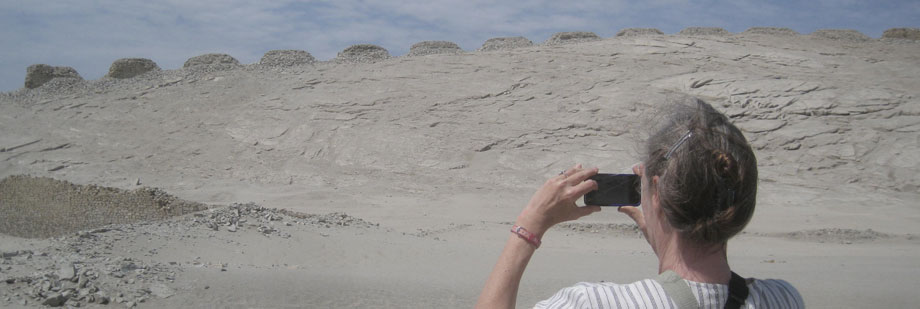THE OLDEST SOLAR OBSERVATORY IN AMERICA
Information and technique of observation of Chanquillo, the Oldest Solar Observatory in America near Casma, Peru.
It was built more than 2,000 years ago, in the coastal area of the Peru and only 400 kms. from Lima, according to a study published by the magazine Science.
The observatory is formed by thirteen on-line lifted towers, from north to south on the summit of Mount Chanquillo that indicated the annual displacement of the Sun, accurately, as well as the solstices and the equinoxes. Also, it contains two artificial points of observation separated by 200 meters with a kind of a fortress surrounded by three concentric rings.
It's construction reveals that the knowledge of astronomy existed in the region before the Inca Empire, according to the archaeologists Ivan Ghezzi, of the Pontificia Universidad Catolica of Peru, and Charles Ruggles, of the University of Leicester, in the United Kingdom. It also demonstrates that there, it was carried out religious rituals linked with the astronomical phenomena.
THE PILLARS OF THE SUN
Up to now, according to the stories of the first cronists, it was believed that the first solar observatories were in the region of the Coricancha, near Cuzco, or they had been built by the Moche Culture, 600 years after Chanquillo. However, those denominated "Pillars of the Sun" that marked the stations and the moment for planting the fields in the region of the Cuzco, they have been erased with the step of time and it's ignored, their precise location. Chanquillo "it is a very previous structure in the Peruvian coast that seems to have been built to facilitate the observations of the Sunset and of the Sunrise", it points out the report.
On the other hand, the archaeological excavations revealed that in the construction, there made this offerings in shape of figures of ceramic warriors' with decorations that would seem to be distinction signs, what suggests ritual practices as well as the existence of social classes. "The adoration of the Sun and the cosmological customs of Chanquillo perhaps have helped to legitimate the authority of an elite class, like it happened with the Inca Empire, two millennia, later", according to the scientists.
In an article of analysis published by Science, the archaeologist Charles Mann picks up the opinions of other scientists that support the idea that Chanquillo was only a solar observatory and not a military fortress of that time. According to Luis Jaime Castle, archaeologist of the Pontificia Universidad Catolica of Peru, is a clear example of a "monumental calendar". "It is difficult to think for another thing it could of served the observation towers", and its presence reveals that it existed very advancedmeasuring techniques, 600 years before the Moche Culture. "This tells us that it is possible that has happened other things that we didn't know", he adds.
But, on the other hand, for Daniel Sandweiss is evident the practical necessity for the residents of that region to have the solar observatory of Chanquillo. According to the scientist, the agriculture was crucial in that time and that area depended on the irrigation provided by the rivers. "The solar observation was necessary to know when it should be planted", according to him.

TECHNIQUE OF OBSERVATION
The archaeological place dates III Century B.C. (Final Formative period). It consists of several circular structures fortified with thick stone walls and plastered with mud, besides 13 towers from which it was observed the movements of the Sun. It is located above a hill and in his surroundings, celebrations must of been made of important religious and political ceremonies during the solstices and the equinoxes, before the presence of thousands of pilgrims' that arrived every year.
According to Iván Ghezzi: "Thousands of People could have been gathered there to observe impressive solar events. These events could of been manipulate in function to a political calendar... for example, during the time of the summer solstice in June, the longest day in the year, the sun comes out exactly to the left of the furthest northern tower." (Agency Reuters).
Before these investigations Chanquillo was considered a fortress with eminently military functions and it was related with the Mochica Culture of the First Regional Development (200-600. C.).
CASMA-SECHIN-CHANQUILLO TOUR
3 DAYS 2 NIGHTS
SEASON: All Year
CATEGORY: 2** STARS
SERVICE: PERSONALIZED EXPERIENTIAL TOUR
PROGRAM DESCRIPTION
DAY 1.- LIMA - CASMA.
DAY 2.- VISIT TO SECHIN AND CHANQUILLO
Day 03.- CASMA - LIMA. OPTIONAL, CONTINUE TO HUARAZ OR CHIMBOTE TO HEAD TOWARDS TRUJILLO (this is on your own).
SERVICES INCLUDED:
Local Transportation IN/OUT, 02 Nights in 3* Hostel, entry fees and bilingual guide.
SERVICES NOT INCLUDED:
Meals are on your own, Tips or neither any type of insurance or rescues.
For further information on the program such as reservations, etc., please Contact Us.



